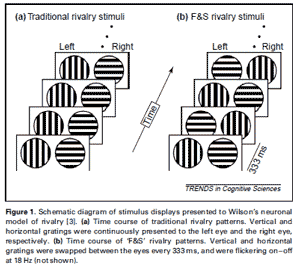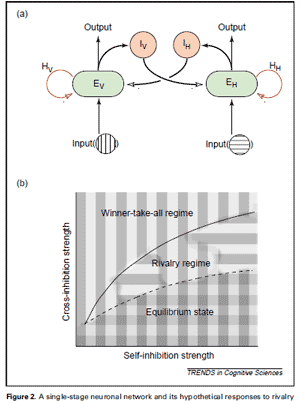简版 mail
作者:李相勋 Sang-Hun Lee / 949次阅读
时间:2009年11月28日
来源: TRENDS in Cognitive Sciences Vol.8 No.4
时间:2009年11月28日
来源: TRENDS in Cognitive Sciences Vol.8 No.4
标签: 双眼竞争
The visual percept fluctuates over time when dissimilar patterns are shown
to the two eyes (binocular rivalry). Where in the brain are the corresponding
fluctuations of neuronal activity? Conflicting results from studies using
various techniques have rendered this question unresolved at present. A recent
paper by Wilson, however, promises to reconcile previous disagreements, as it
demonstrates that rivalry can be located at different stages of the neuronal
hierarchy, depending on the nature of stimulation.
When the brain receives conflicting information about the outer world, it
adopts a strategy of changing its interpretation over time, rather than sticking
to a single interpretation or holding multiple interpretations
simultaneously. As an extreme case, consider your left eye viewing a vertical
grating while the right eye views a horizontal grating, as illustrated in Figure
1a. Instead of seeing both patterns superimposed or, alternatively, one
exclusively, you will see the vertical grating for several seconds and then the
horizontal grating for several seconds, the phenomenon called binocular rivalry
[1,2].
双眼竞争中最有趣的特点之一是:即使呈现在视网膜上的刺激仍未改变,视知觉中感受到得图片会间歇性地消失。受到直觉经验和物理刺激显著分离的鼓舞,神经科学家们视图通过研究双眼竞争去发现在大脑中,不和谐的神经元表现形式是怎样及在大脑的何处争夺视觉意识的优先地位的。这些研究本身就像双眼竞争得现象一样,产生了从表面上看模棱两可的研究结果,使得双眼竞争的神经元基础这一问题仍悬而未决。最近,Wilson延续了他在知觉双稳定性的神经元模型的早期研究工作,这一后续研究为通过在一个生物物理学下的似是而非的模型下模拟竞争的不同形式来协调先前的研究结果提供了有见地的线索。
One of the most intriguing features of binocular rivalry is that a pattern intermittently disappears even though its retinal stimulation remains unaltered. Inspired by this striking dissociation between perceptual experience and physical stimulation, neuroscientists have studied binocular rivalry to try to find out how and where in the brain incompatible neuronal representations battle for dominance in visual awareness. These studies themselves, like the rivalry phenomenon, have yielded seemingly ambiguous results, leaving the issue of the neuronal basis of binocular rivalry unresolved. Recently,Wilson [3], extending his earlier work on neuronal models of perceptual bistability [4,5], provided an insightful clue towards reconciling the previous results by simulating different forms of rivalry with a biophysically plausible model.
关于双眼竞争的竞争观点Rival ideas on binocular rivalry
为了体会Wilson研究发现的重要性,让我们先来看下关于双眼竞争的神经元基础的竞争观点。第一个论点叫“两眼间的竞争假设”,推测对抗是双眼神经竞争的结果,这些神经用来保存单眼偏好信息。另一个观点叫做“图像竞争”假设。该观点认为,双眼竞争包括了在刺激形式不相配的结果之间的竞争,而不包括它们的单眼线索的竞争。
To appreciate the importance of Wilson’s findings, let us first review two
competing ideas on the neuronal underpinnings of binocular rivalry. One view,
called the ‘interocular competition’ hypothesis, construes rivalry as
the outcome of competition between the eyes among neurons whose signals preserve
preference for their monocular origin [6,7]. An alternative view, called the
‘pattern competition’ hypothesis, holds that rivalry involves
competition between incompatible representations of stimulus patterns, not
between their monocular
sources.
精神物理学研究的大量结果支持这“两眼内竞争假设”。比如,在竞争的抑制阶段,视觉灵敏度的丧失不是受现象上的抑制性刺激的限制。而是这种丧失发展到呈现给受抑制的眼睛的任何刺激。此外,在双眼竞争中当竞争形势在两眼间交换时,在优势领域的瞬间转换是典型的经验性的。这些结果预示着在双眼竞争中正在被抑制的刺激是一个眼睛视觉领域的神经元表现形式,而不是呈现的特定刺激。更确切的,另一个支持“两眼内竞争假设”的证据来自于一个fMRI功能性磁共振成像研究,在这个研究中,在双眼竞争时知觉的起伏紧紧伴随着在人类初级视觉皮层的盲点范围内单眼神经元的调制活动。
Considerable evidence from psychophysical studies supports the
interocular-competition hypothesis. For example, the loss of visual sensitivity
during suppression phases of rivalry is not restricted to the phenomenally
suppressed stimulus but generalizes to any input presented to the suppressed eye
[8–10]. In addition, an instantaneous reversal in dominance is typically
experienced when rival patterns are swapped between the eyes during
rivalry [11,12]. These results indicate that what is being suppressed during
rivalry is the neuronal representation of the visual field of one eye, not the
specific stimulus presented. Another, more direct, piece of evidence
supporting the interocular-competition hypothesis came from an fMRI study [13],
in which perceptual fluctuations during rivalry were tightly coupled with
modulations in activity of monocular neurons within the blind spot in
human primary visual cortex.
相比之下,来自关于唤醒的电生理学研究结果表明, 行为着的猴子似乎反对“两眼内竞争假设”。在双眼竞争中,只有一小部分的神经元在初级视觉皮层显示firing rate的调节活动。只有在更高级的视觉领域(比如下颞叶皮质)才显示与猴子的知觉报告相关的神经元活性。最挑战“两眼内竞争假设的证据来自于一个心理物理学实验,在这个实验里,以特定眼睛和特定图像成分的竞争是被分开的。再去思考图1a中那两个以直角为导向的栅栏,但是呈现出它们闪烁着,在一秒钟内在两个眼睛之间重复地交换着,正如图片1b显示的那样。如果视觉系统选择了一个基于其眼睛边缘的神经元表佂,这样观察着们就会看到一个在一秒内定期变换自己方向的闪烁着的栅栏。然而,在某些观察条件下,其中的一个栅栏在几秒钟里仍然是可视的,尽管事实是在那段时间里正进行着两个眼睛的转换。如果双眼竞争包括了以眼睛为单位的竞争那么会出现不可能的结果。这个对抗刺激(称之为“F&S”对抗,for闪烁和“眼球转动”,wilson),暗示了 在双眼并用之后对抗来自于在视觉加工层次的高水平上的神经元。
By contrast, results from electrophysiological studies on awake, behaving
monkeys seem to argue against the interocular-competition hypothesis. Only a
small proportion of neurons in primary visual cortex showed modulation of firing
rate during rivalry [14], and only within higher visual areas, such as
inferotemporal cortex, was neuronal activity correlated with the monkey’s
perceptual reports [15]. The most challenging evidence against
interocular competition was provided by a psychophysical experiment, in which
eye-specific and pattern-specific components of rivalry were uncoupled [16].
Consider again the two orthogonally oriented gratings of Figure 1a, but
presented such that they are flickering on and off rapidly and being repeatedly
swapped between the eyes several times a second, as depicted in Figure 1b. If
the visual system selected a neuronal representation based on its eye of origin,
then observers would see a flickering grating that periodically changed its
orientation several times a second. Under some viewing conditions, however, one
of the two gratings remains visible for several seconds in spite of the fact
that it is being swapped between the eyes many times during that period, an
impossible outcome if rivalry involved eye-based competition. Instead, this
‘stimulus’ rivalry (called ‘F&S’ rivalry, for ‘flickering and
eye-switching’, by Wilson) implies that rivalry arises from competition among
neurons at higher levels in the visual processing hierarchy, after binocular
convergence.
在同一的神经回路里,传统的和F&S对抗不能共存Traditional and F&S rivalry cannot coexist within the same neuronal circuit
所以,关于基于对抗的神经基础的研究,发现的结果极不统一。然而,这可能是因为这个困境是来自于开始的一个正确的假设——即双眼对抗通过一个特定神经元一侧的单一机制下调解。根据这一观点,Wilson通过测试一个假设的单级网络是否足够可行以至于能够容纳两种不同形式的竞争(传统竞争和F&S竞争),检查了一个单一竞争机制的假设是否在生物物理学上可行。
So, the findings surrounding the neuronal basis of rivalry appear to be in
strong disagreement, leaving us with a conundrum difficult to resolve. However,
it could be that this dilemma arose from an incorrect assumption at the outset –
that binocular rivalry is mediated by a single mechanism at a particular
neuronal site. In line with this idea,Wilson examined whether the assumption of
a single rivalry mechanism is biophysically feasible by testing whether a
hypothetical single-stage network is flexible enough to accommodate two
different forms of competition, traditional rivalry and F&S rivalry
[3].
思考下一个神经元网络同时包含着兴奋性的和抑制性的神经元(图2a)。兴奋性神经元是方向选择性的,是靠外部输入的刺激驱动的。在神经元网络内建立两种类型的抑制加工
以发展两种竞争(相互抑制:一个知觉对象的激活伴随着另一个知觉对象的抑制和支配领域的变换:竞争的优胜者随着时间不断重复变化)的显著性特点。“相互抑制”由交互抑制法执行,经由抑制性中间神经元(IH
and IV)到以直角方向为选择性的兴奋性神经元(EH and EV)。
Consider a neuronal network comprising excitatory and inhibitory neurons
(Figure 2a). Excitatory neurons are orientation selective and driven by external
inputs. Two types of inhibitory process are built into the network to foster two
signature characteristics of rivalry, ‘mutual inhibition (one percept is
dominant at the expense of its competitor being suppressed)’ and ‘alternations
in dominance (a winner of the rivalry battle is changing repeatedly over time)’
[3]. ‘Mutual inhibition’ is implemented by reciprocal inhibition between
excitatory neurons selective for orthogonal orientations (EH and EV)
via inhibitory interneurons (IH and IV). To capture ‘alternations in dominance’,
excitatory neurons inhibit themselves through slow, spike-frequency adaptation
that is due to after-hyperpolarizing currents (HH and HV)
[17].
面临着两个直角相交的栅栏,这个网络的行为依靠着交叉抑制和自我抑制的相对力量大幅度的转换着不同的状态(图2b)。如果交叉抑制的力量太强,那么只有两个兴奋性神经元中的其中一个会持续兴奋,预示着只有一个栅栏能被永远看到(赢家通吃制度)。只有在两种类型的抑制力量相互平衡时对抗才会存在。
Faced with two orthogonally oriented gratings, this network’s behavior
shifts between dramatically different states depending on the relative strengths
of crossinhibition and self-inhibition (Figure 2b). If cross-inhibition is too
weak, there will be no competition, predicting that the two gratings will be
seen simultaneously (‘equilibrium state’). If cross-inhibition is too strong,
only one of the two excitatory neurons will be excited continuously and
the other will never be released from suppression, predicting that only one
grating will be seen permanently (‘winnertake- all regime’). Rivalry will be
achieved only when the forces of the two types of inhibition are balanced
suitably. In quantitative terms, a set of possible balanced pairs of inhibition
values would define a region in parameter space within which rivalry occurs
(‘rivalry
regime’).
在这种竞争制度下,我们可以测试竞争的不同形式是否可以在单一网络里存在。如果单一网络里的神经元竞争足够去说明传统竞争和F&S竞争,他们必须共存于同一参数空间。根据Wilson的模拟结果并不是这种情况。传统竞争的对抗机制与F&S竞争十分不同。推动传统竞争的交叉抑制的力量太弱不足于制造对F&S竞争的压力,然而F&S的竞争力量很强,它足于在传统竞争形式上制造支配领域的变换。
Within the rivalry regime, we can test whether different forms of rivalry
can occur in a single network. If neuronal competition in a single network is
sufficient to account for both traditional and F&S rivalry, they must
coexist within the same parameter space. According to Wilson’s simulation
results this is not the case. The rivalry regime for traditional rivalry turns
out to be quite separate from that for F&S rivalry. The force of
cross-inhibition that subserves traditional rivalry is too weak to produce
suppression for F&S rivalry patterns whereas the force of cross-inhibition
that works for F&S rivalry is too strong to produce alternations in
dominance for traditional rivalry patterns.
在分等级阶段的神经元竞争Neuronal competition at two hierarchical stages
Wilson推理到在F&S竞争形式上强烈的瞬息信号减弱了交叉抑制的效率,所以F&S竞争需要交叉抑制力量不断加强的附加竞争网络。使用一个由两个分层次网络的新模型可以检验这种推理,一个伴随着较弱的交叉抑制执行内部竞争,另一个伴随着较强的交叉抑制执行着图像形式竞争。这种two-stage模型制造了令人感兴趣的结果。第一阶段的两眼间的竞争成功产生了针对传统竞争形式的竞争性波动。然而,F&S竞争在单眼阶段并没有得以解决,但是在之后的单眼阶段可以解决。另外,两眼间的快速闪动和刺激转换对在第一阶段避开单眼竞争时十分必要的,结果是与心理物理学数据联系紧密。
Wilson reasoned that strong transient signals in F&S rivalry patterns
attenuate the efficacy of cross-inhibition, and therefore that F&S rivalry
requires an additional competitive network with increased cross-inhibition
strength. This reasoning was tested using a new model, consisting of two
hierarchical networks, one implementing interocular competition with weak
cross-inhibition and the other implementing pattern competition with strong
cross-inhibition. This two-stage model produced intriguing results. Interocular
competition at the first stage successfully generated rivalry fluctuations
in response to traditional rivalry patterns. However, F&S rivalry was not
resolved at the monocular stage, but instead at the later, binocular stage. In
addition, both rapid flicker and stimulus swapping between eyes were necessary
to bypass monocular competitions at the first stage, a result that aligns well
with psychophysical data
[18].
结论Wilson研究的关键发现是什么?他的文献中介绍说,在传统竞争和F&S竞争适应于单一竞争网络里并不是似是而非的,不管这个网络是单眼驱动还是双眼驱动。这一点警告我们假设单机机制能适应于各种形式的知觉波动是过于简单的,只能给予暂时的支持,但是日益达成共识是双眼竞争是通过随着视觉加工层次多重神经元网络分布的,
What is the key finding ofWilson’s study? It demonstrates that it is not biophysically plausible to accommodate both traditional and F&S rivalry in a single competitive network, regardless of whether that network is driven monocularly or binocularly. This serves to warn us that it is an oversimplification to presume that a single mechanism is applicable to all forms of perceptual instability, and lends timely support to the recent but growing consensus that binocular rivalry comes about through multiple neuronal sites distributed within the visual processing hierarchy [19–22].
另一方面,尽管传统和F&S竞争的皮层营养基础可能处于不同的神经元网络,而且值得一说的是这两种网络操作相似。在Wilson对抗模型、交叉抑制、自我抑制中神经元的计算对解释其他多元稳定现象(包括数字图像转换、动力深度转换、单眼竞争)可能是至关重要的。这就是为什么包括双眼竞争在内的多元变化的稳定现象显示出相似的时间变化。
On the other hand, although the cortical substrates for traditional and
F&S rivalry are likely to be situated at different neuronal sites, it is
also noteworthy that these two networks operate similarly. It is possible
that the neuronal computations in Wilson’s rivalry model, cross-inhibition and
self-inhibition, might be crucial for explaining other multistable phenomena,
including figure–ground reversal, kinetic-depth reversal, and monocular rivalry.
And perhaps this is why diverse multistable phenomena, including binocular
rivalry, show similar temporal dynamics [23].
Wilson的工作是在神经科学领域计算机模型作用的典范,这里不仅提供了对之前相冲突的研究发现提供了理论性的计算,而且通过进行可测试的语言指导着未来的研究。当竞争形式时空结构变化时,其中的挑战—分解双眼竞争的复杂性质的方法—是对于神经元反应进行多元测量及同时更好的定义变量。这样的挑战 如果我们想要彻底解决这个知觉领域里长期滞留的问题就必须迎接好这些挑战。Wilson’s work is an elegant example of the role of
computational modeling in neuroscience, in that it not only offers a
theoretical account for previously conflicting findings but also guides future
studies by making testable predictions. One challenging but promising way of
unraveling the complex nature of binocular rivalry would be to measure neuronal
responses at multiple, well-defined sites simultaneously, while parametrically
varying spatiotemporal structure of rivalry patterns. Such challenges must be
taken if we are to get to the bottom of this longstanding question in
perception.


No comments:
Post a Comment